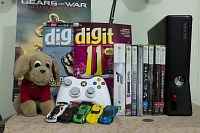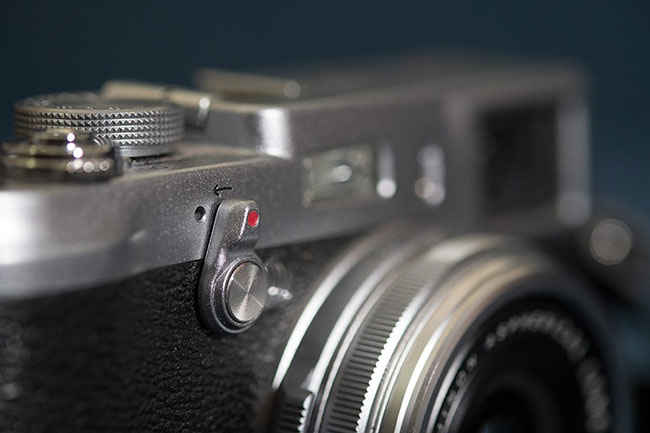The Fujifilm X100 was a redefining camera for the point and shoot segment, but sadly, it shipped with many flaws. However, the X100s feels like a camera made by a company that listens to its customers. Not only does the new camera inherit no flaws from the X100, but it also brings with it a set of new features that are sure to win many over. But the price on the X100S can be a deterrent for a few along with its fixed focal length lens. But there�s a lot more to the story, so read on.
So, with the year beginning anew, it was only expected that Fujifilm would update the X100 with a new model. The X10 got replaced with the X20, so naturally, the X100 was to be replaced with the X200 right? Wrong! Fujifilm released the upgrade under the name of X100S. Once this reviewer managed to contain the excitement of the announcement, a question arose. What does the “S” stand for? We reached out to Fujifilm India to get our hands on the X100s early so that we could understand why the company chose to add a letter and not a number of the camera’s nomenclature. Here’s what we have found so far.
S is for Simplicity:
One glance at the X100S and there is no way to tell it’s a camera different from its predecessor, save for that little “s” emblazoned on the bottom right corner (or bottom-left, it’s all about perspective with us photographers). It has the exact same look and build as the X100. Flip the camera over and there’s a very good chance you won’t notice the only change the camera’s exterior has undergone. The “RAW” button on the X100 has been replaced with a “Q” button, the same one found on the X-Pro1, which brings instant access to most of the imaging features of the camera. That’s about all the exterior changes. Fujifilm has kept the design philosophy rather simple, sticking to the old rangefinder build. Looks like Fujifilm took the “if it ain’t broke, don’t fix it” saying to heart!
Fujifilm in fact steps it up a notch with the X100s. Seeing how photographers absolutely loved the hybrid viewfinder of the X-Pro 1, the company decided to include that module in the X100S too. The EVF allows the user to switch between the “real world” view with an information overlay and an actual electronic viewfinder just by the flick of a switch placed conveniently on the front of the camera.
S is for Specifications:
The specs on the X100S are quite similar to the X100. It’s got an upgraded 16 megapixel X-Trans II sensor which is complimented by the new EXR II image processing chip. The X-Trans II sensor isn’t just a change in number, but is a significantly improved sensor from before. For starters, not only does it employ the Back Side Illuminated design, but also gets dedicated phase detection pixels that have allowed the X100s to become the fastest focussing point and shoot camera so far.
The front of the X100S is graced by a Fujinon 23mm f/2.0 lens (which gives a 34.5mm field of view) which, just like on the predecessor, has a minimal footprint. The lens however, has been optically improved and this is where the EXRII chip comes into play. Besides pushing off the 6 frames per second burst mode, the EXRII chip also applies real-time lens correction data to the images to correct for vignette and chromatic aberration, and from what we’ve seen, it does a splendid job.
S is for Shutter Splendour:
Fujifilm pretty much pulled out all stops and replaced the normal “focal-plane” shutter found on pretty much every camera in the market, with a leaf shutter. Moving past the awkward name, a leaf shutter brings with it some serious chops. For starters, you can now sync your flash with shutter speeds up to 1/1000th of a second. Conventional DSLRs max out their shutter sync speeds at 1/250th of a second, so the ability to be able to use your speedlight at incredibly high shutter speeds should really excite you.
We must clarify one thing though. You might hear a claim of “being able to sync flash at any shutter speed,” which happens to be both true and false. While it is true that the shutter shouldn’t exhibit any shadow banding, the flash sync depends on your Speedlight’s pulse duration. While we could get into the nitty gritties of the pulse duration and what not, but we’re just going to keep it simple and say that going up to 1/1000th of a second wouldn’t be a problem.
The magic of the shutter doesn’t just stop there. The leaf shutter is also dead quiet. We don’t mean whisper quite, but we mean dead quiet. You could take this camera into the most silent place you can find (even a sound isolation chamber) and fire it off at its fastest 6 frames per second and you wouldn’t hear a thing. It is so quiet that Fujifilm had to give the option for simulated shutter sounds in the menu, which you have three of to choose from.
S is for Speedy
The Fujifilm X100S is all about speed. The original X100 had a slow AF, but the on-sensor phase detection puts this camera far ahead of the competition. That probably sounds like marketing spiel, so we’re going to tell you just how we tested the camera.
We had the camera on AF-S setting for the most part, because we wanted to make the most of the 49 point AF area the X100S offers. This is the same across all X-series cameras, as is the ability to change the size of the AF point in various steps for better accuracy. When it came to regular snapshots of people, objects still life etc, the camera had no issues locking focus whatsoever.
We figured that shooting everyday subjects in good lighting was probably not an effective test of the X100S AF system, so we decided to go a little overboard. We took the X100S to an underground concert being hosted in a really dingy part of town. No lights except for one string of cheap LEDs lit the room and we knew that this would be a fitting challenge. We shot for an hour with the AF Assist lamp turned on (obviously!) and managed to nail every single shot. We found it harder to pick up our jaws from the floor than the X100S did to lock focus on a DJ tearing the roof off this shady venue.
The one area where people are bound to run into trouble is the Macro mode. Once the macro setting is enabled though the back, the AF becomes wildly slow, which is actually expected. In order to achieve fast AF, the camera internally uses an AF limiter, which gets disabled when the Macro Mode is enabled. In Macro mode, the camera performs a far more fine-tuned hunt for focus, which can be time consuming, which we did find a little disappointing.
The speed of the X100S is also due in part to the EXR II image processing chip, which adopts a dual-CPU and increased clock frequency design to deliver increased performance – supposedly twice that of the previous generation processor.
If you’re wondering whether the X100S has any chops in real world, day-to-day usage, well, rest assured that between the time it takes you to turn the thing on and bring it to eye level to frame your shot, the internals are prepped and ready to fire off the shot – rated at roughly 0.5 seconds.
S is for Stunning:
The X100s has a new large sensor with a Back-Side Illuminated design. The original X100 delivered excellent image quality to begin with, but with an updated design, we’re seeing much better performance, especially in low light.
Remember that shady underground concert we talked about? So that whole gig was shot at f/2.0 with the ISO set to ISO 3200 and a 1/30th of a second shutter speed. We lit up the scene with an off camera flash, since the venue was devoid of all lights. In pitch dark, there were enough shadow areas that we expected should develop noise very quickly, but lo and behold! They didn’t! Check out the sample below:
We also managed to grab this lovely shot at a local night club with beautiful blue and ultra violet lights graced by tungsten filament bulbs in the foreground. The camera once again did a really good job of capturing the dynamic range of the scene without blowing out to much of the highlights or losing too much detail in the shadows. You can see those photos in our image gallery.
If you shoot RAW on the X100S, the files will give you a pleasant amount of headroom to work with exposure, contrast, colour balance and even dynamic range. We were able to push out a whole stop worth of dynamic range from our files, if we needed to. You can feast on the beautiful images from this camera in our gallery.
-small.jpg) |
-small.jpg) |
-small.jpg) |
-small.jpg) |
-small.jpg) |
-small.jpg) |
-small.jpg) |
-small.jpg) |
-small.jpg) |
-small.jpg) |
-small.jpg) |
-small.jpg) |
-small.jpg) |
-small.jpg) |
-small.jpg) |
-small.jpg) |
-small.jpg) |
-small.jpg) |
-small.jpg) |
-small.jpg) |
-small.jpg) |
-small.jpg) |
-small.jpg) |
-small.jpg) |
One last bit of advice, colour gel that flash up front! We noticed that under normal circumstances, our images shot using the flash on the front of the X100S came out a little too cold for our liking. However, once we had placed a warming gel on the front of the flash, the exposures came out just about right. If you’re thinking you can correct the white balance in post to get a pleasing look, be ready to work with a lot of masks and layers to get the colour temperature right. Keep it simple and just use a warming gel. We simply taped ours to the front.
 ISO 200 |
 ISO 400 |
 ISO 800 |
 ISO 1600 |
 ISO 3200 |
 ISO 6400 |
S is for Satisfaction:
We can’t fully express just how amazing it has been using the X100S. For us, there was not a single situation where we felt the X100s was not capable of delivering what we required of it. Earlier, we had stopped carrying our DSLR around in favour of the X-Pro1, an excellent mirrorless camera from Fujifilm and now, we found ourselves leaving even that at home and just bouncing around the city with the X100S.
However, we should mention a few caveats. For starters, don’t let the X100S’ rangefinder design fool you. The camera is, at the end of the day, a point and shoot, which means that there is no option of changing lenses. In fact, the lens on the X100S is a single focal length lens (34.5mm) which means it cannot zoom. If you’re a lazy photographer, this would definitely start getting on your nerves once the novelty of owning a new camera wears off. Rs. 74,999 is a lot of money to shell out for a non-zooming camera, as some might say. But then again, we also have the Sony RX1 which costs more than twice the amount, has the same lens (35mm f/2.0) but instead of an APS-C sensor, uses a full frame chip. If you are serious about a workhorse of a camera, and have been considering the RX1 as an option, we recommend also taking a look at the X100s.
Lastly, the one drawback of the X100s is also its biggest USP; its form-factor. While many of us will drool until our glands run dry over the rangefinder design and the hybrid viewfinder (another one straight out of the X-Pro1), some might find it a little bulky and not so pocket friendly. In fact, finding a case for this camera might be in of itself a task (though we feel the camera is a tough one and can take any regular day use and abuse).
Swapnil Mathur
Swapnil was Digit's resident camera nerd, (un)official product photographer and the Reviews Editor. Swapnil has moved-on to newer challenges. For any communication related to his stories, please mail us using the email id given here. View Full Profile









